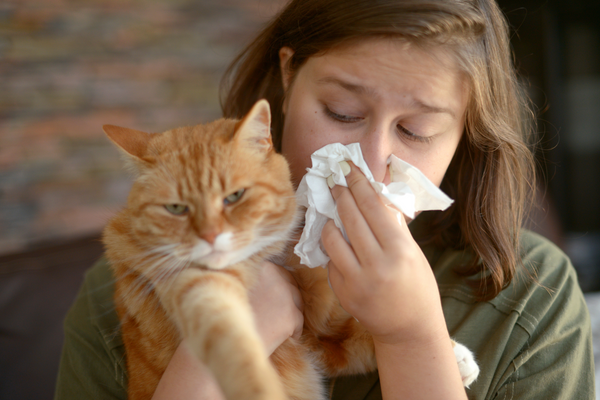Spring Cleaning: Comforters & Duvets

Spring has officially sprung, and while you’ve probably already gotten a head start on your annual cleaning fest, don’t overlook one of the most important places in your home: your bed. You wash your sheets on a regular basis, but it’s likely that your comforter or duvet could use a little springtime freshening. After all, your bedding can harbor germs as well as allergens like dust mites that can ruin a good night’s sleep, so it’s important to know how to wash it the right way. Most comforters should be washed two to three times per year to keep your bed fresh and clean (and your allergies at bay). Luckily, washing a comforter – even one made from down or synthetic fibers – is nearly as easy as doing a regular load of laundry.
It’s time to get rid of winter in your bedroom, so follow our step-by-step guide to freshen up your sleep sanctuary.

Materials Needed
1. Follow the Care Instructions
Before you throw your bedding into the washing machine, always check the care direction labels to see the manufacturer's instructions on how to wash and dry it. Keep in mind that some materials, such as wool or silk, can be damaged in the washer or dryer, so if the label says “Dry Clean Only”, it’s best to let the professionals handle things. If the label says it’s okay to machine-wash and dry, be sure to follow any specific instructions, such as using cold water or drying on low heat.
It’s also worth mentioning that down comforters can usually be washed. While it’s a common misconception that down comforters always have to be taken to a dry cleaner, unless the label specifically instructs otherwise, you can definitely wash it at home. Just keep in mind that down comforters should only be washed once or twice per year to avoid stripping the natural oils from the feathers of the down. To keep down comforters as clean as possible between washings, consider using a cover that you can wash regularly.
2. Remove Stains & Repair Tears
Before washing, spot-treat any stains with Vital Oxide. Simply move the filling away from the stain, spray Vital Oxide full-strength straight from the bottle and dab with a damp microfiber cloth to lift the stain. Repeat as needed. After treating any stains, you’ll also want to check for any loose threads or torn seams and repair them to prevent further damage in the washer and dryer.
3. Use the Right Washing Machine
Not sure if your washer is up to the task? A large front-load washer is ideal, but if your comforter or duvet is queen-size or smaller, a regular washer should do the trick. A good rule of thumb is that your comforter or duvet should fit inside the washing machine with room to spare. It’s always best to wash a comforter on it’s own (resist the urge to throw in some clothes!). You want to make sure your comforter has as much room as possible when it’s washing. Otherwise, the filling may get compressed (and no one likes lumpy bedding), and the comforter won’t get an even clean.
4. Choose the Appropriate Laundry Detergent & Washing Cycle Settings
Use a gentle, fragrance-free, Anti-Allergen Laundry Detergent to eliminate stains, odors, and common indoor allergens from dust mites, pet dander, molds, and mildew. Our Anti-Allergen Laundry Detergent was designed to work well in cold water, which is ideal for washing your comforter or duvet. If you need to sanitize your bedding after someone has been ill, or have extra funky odors or extra stubborn set-in stains that need tackling, add 1 cup of Vital Oxide directly to the washing machine along with the detergent.
Once you’ve added detergent and selected the wash temperature, select the “delicate” or “gentle” cycle and add an extra rinse to the cycle. After the cycle has finished, if you find that your comforter or duvet is still quite wet, run the spin cycle an extra time to remove excess water.
5. Dry Your Bedding with Dryer Balls
Some bedding will do well drying outside on a line in the fresh spring air. Others, like fluffy comforters and duvet covers, will dry best in the dryer. Once your bedding has been washed and the excess water has been wrung out, transfer it to the dryer. (If it’s too tight of a fit, you may also need to use a commercial dryer at the laundromat.) Add a few wool dryer balls (or clean tennis balls) to the load to help evenly distribute the filling and speed up the drying time.
Remember to check the care label for the suggested dry temperature. Generally, if your comforter or duvet is made from synthetic materials, it should be dried on a low to medium heat setting and high heat should be avoided. Down and other natural materials can’t stand much heat either, so set your dryer on “air dry” or “low dry” and allow them to dry thoroughly. Remove the comforter from the dryer every half hour or so and fluff to redistribute the filling. Return to the dryer and continue the cycle. This will help to ensure that it dries evenly.
6. Keep Your Bedding Fresh All Year Round
In between washings, if your comforter or duvet needs to be freshened up but not full-on laundered, start by spot cleaning and removing stains with Vital Oxide and a damp cloth. Be sure to check for tears and make any necessary repairs. Next, put it in the dryer on low heat with a few wool dryer balls. Stop the dryer about every 10 minutes to shift around the comforter or duvet and repeat for a total of 30 to 40 minutes. This process will fluff up your duvet or comforter and redistribute the filling. After you’ve run it through the dryer, lightly spray your comforter or duvet with our Anti-Allergen Solution and let air dry to neutralize allergens from dust mites, pollen, pet dander, and more.
Have questions about deep cleaning or reducing allergens? We have answers! The Ecology Works has been helping people with allergies and asthma since 1993. We can help you select the products you need to live a better, allergen-free life. Please feel free to Contact Us or message us on Facebook. No question is too small! We’re here to help.




